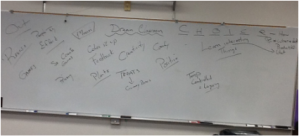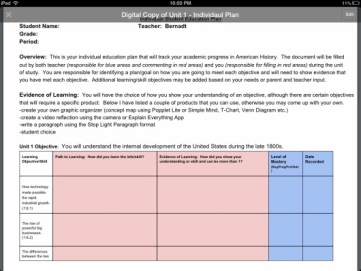What is your dream classroom? This is the question I presented to one of my classes on the second day of school. My objective was to provide students with a hand in creating the classroom setup and expe ctations. What students did not know yet was that I had already chosen them as the class that would be using my class set of iPads (which they could eventually take home each night)! I did not want students to know about the iPads for a few days. The last thing I wanted was my students distracted by the iPads, instead, I wanted to focus on setting up the learning environment with students.
ctations. What students did not know yet was that I had already chosen them as the class that would be using my class set of iPads (which they could eventually take home each night)! I did not want students to know about the iPads for a few days. The last thing I wanted was my students distracted by the iPads, instead, I wanted to focus on setting up the learning environment with students.
The activity started by providing students with 10 minutes to brainstorm ideas. I wanted them start their dream creation independently (note that students were reminded that we still had to complete district objectives and the district unit tests). Students were then placed in groups of four and given 20 minutes to share their ideas and begin creating their dream classroom as a small group. Finally, we circled up as a class and created our dream classroom together. The picture above is the end of a 25 minute discussion with students on what they wanted their dream classroom to look like. It was an interesting discussion that was a lot more calm than I had envisioned it. The students seemed very focused and thoughtful, although there were some pretty funny ideas that did not make the board (students had to agree on the ideas placed on the board). I was pleased with a number of things students presented, which included: creativity, comfy, positive, games/create games, feedback, effort/people try, revise, and treats (specifically, gummy bears)! But the one that has had the biggest impact on our classroom? CHOICE. It became clearly early on in the discussion that students wanted more choice. They wanted to choose how they learn, where they learn, what they learn and how they show their learning. At the end of the discussion I took a picture with my iPad and told students that it was now my job to create their dream classroom.
The next three weeks included a number of introductory activities and themes that focused on setting up the learning environment and teaching skills that students would need to be successful within the classroom (this includes basic iPad skills/workflow, digital citizenship lessons, and analyzing America today). All of this provided me with time to visualize and create my students’ dream classroom. Using ideas that came out of summer reflection and personal guided professional development (the foundation being Twitter) I created an Individual Student Education Plan that would set the foundation of my class. The idea was inspired by both my students request for choice and NETA13 keynote speaker Adam Bellow who discussed his feeling that every student should have an IEP. I was also wrestling with the idea of utilizing strategies centered around flipping the classroom, with inspiration and ideas coming from Tom Driscoll.
I went about breaking down the required material into clear learning objectives. The document below is the first page of a five page document that would be used to track each student’s learning during a unit of study. For each objective students must reflect on their path to learning and document their evidence of learning. I then went to work gathering together learning materials for students that includes: creating my own learning videos for students, finding quality video clips and websites, primary source documents, learning activities, and other resources. iTunes U is my go to app to share all these materials with students. It is important to note that students do have the choice to go outside of my materials to learn the objectives, which could be as easy as accessing their textbook or the internet.
Each week is broken up in two ways: Activity Days and Choice Days. Although there is no set number or schedule students will have on average three choice days a week. On Choice Days students have the choice on how, where, and what they learn. They can either spend the time learning the material or working on their products that will show their learning. I spend the time moving from one student to the next checking in on them, discussing the material, answering questions and checking student work. One of the main goals is to assess student work with them, face to face. This leads to timely feedback that includes the student reflecting on their work right then and there. It allows for a perfect time to check for understanding by asking students direct questions without them feeling pressure in front of the class.
Activity Days are teacher led lessons that get students actively involved in their learning and can range from class discussion to small group activities and simulations. The key is that students are doing something! What it
shouldn’t be is simply them listening to me lecture as my students can view my video lessons any time they want. This setup provides my students and I a lot of freedom throughout the week, something we all want!
Although my class is only two weeks into this process it has been very rewarding. As with anything it is not perfect and as a class we are constantly working together to improve it. I have no idea where my class will take this challenge, but I look forward to taking the journey with them.
